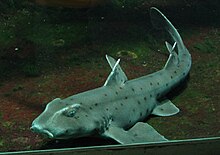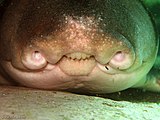Order of sharks
Bullhead sharkTemporal range:
183–0 Ma Early Toarcian to Present[1] [2]
PreꞒ
Ꞓ
O
S
D
C
P
T
J
K
Pg
N
Horn shark , Heterodontus francisci
Scientific classification
Kingdom:
Animalia
Phylum:
Chordata
Class:
Chondrichthyes
Subclass:
Elasmobranchii
Infraclass:
Euselachii
Superorder:
Selachimorpha
Order:
Heterodontiformes L. S. Berg , 1940
Family:
Heterodontidae J. E. Gray , 1851
Genus:
Heterodontus Blainville , 1816
Species
See text
The bullhead sharks are a small order (Heterodontiformes ) of modern sharks (Neoselachii ). The nine living species are placed in a single genus, Heterodontus Heterodontidae . All are relatively small, with the largest species reaching just 1.65 metres (5.5 ft) in maximum length. They are bottom feeders in tropical and subtropical waters.
The Heterodontiforms appear in the fossil record in the Early Jurassic , well before any of the other Galeomorphii , a group that includes all modern sharks except the dogfish and its relatives. However, they have never been common, and their origin probably lies even further back.
Description [ ] This section does not cite any sources . Please help by adding citations to reliable sources . Unsourced material may be challenged and removed . (July 2019 ) (Learn how and when to remove this template message )
The bullhead sharks are morphologically rather distinctive. The mouth is located entirely anterior to the orbits. Labial cartilages are found in the most anterior part of the mouth. Nasoral grooves are present, connecting the external nares to the mouth. The nasal capsules are trumpet-shaped and well-separated from orbits. Circumnarial skin folds are present, but the rostral process of the neurocranium (braincase) is absent, although a is present. Finally, the braincase bears a .
The eyes lack a nictitating membrane . A spiracle is present, but small. The dorsal ends of the fourth and fifth branchial arches are attached, but not fused into a "pickaxe" as in lamniform sharks . Heterodontiforms have two dorsal fins , with fin spines, as well as an anal fin . The dorsal and anal fins also contain basal cartilages , not just fin rays.
Species [ ] Nine living species of bullhead shark have been described:
Heterodontus francisci (Girard , 1855) (horn shark)Heterodontus galeatus (Günther , 1870) (crested bullhead shark)Heterodontus japonicus (Maclay & W. J. Macleay , 1884) (Japanese bullhead shark)Heterodontus mexicanus ( & Castro-Aguirre , 1972) (Mexican hornshark)Heterodontus omanensis (, 2005) (Oman bullhead shark)Heterodontus portusjacksoni (F. A. A. Meyer , 1793) (Port Jackson shark)Heterodontus quoyi (Fréminville , 1840) (Galapagos bullhead shark)Heterodontus ramalheira (J. L. B. Smith , 1949) (whitespotted bullhead shark)Heterodontus zebra (J. E. Gray , 1831) (zebra bullhead shark)
A Port Jackson shark , Heterodontus portusjacksoni
Dentition and oronasal grooves of a Port Jackson shark
See also [ ]
Sharks portal
List of prehistoric cartilaginous fish References [ ] Further reading [ ] show Sharks
Topics
Outline of sharks Shark anatomy Shark teeth Egg case (Chondrichthyes) Threat display Threatened sharks Taxonomy Human
Shark attack
Shark attack prevention Shark cage diving Shark culling
Shark tourism Related
Category WikiProject
show Extant cartilaginous fish orders
Kingdom Animalia
Phylum Chordata
Subphylum Vertebrata
Infraphylum Gnathostomata Elasmobranchii
Selachii (sharks) Batoidea (rays)
Holocephali
Chimaeriformes (chimaeras)
show Extant shark species
Kingdom Animalia
Phylum Chordata
Subphylum Vertebrata
Class Chondrichthyes
Subclass Elasmobranchii
Subdivision Selachii
show Order Carcharhiniformes (Ground sharks)
Hemigaleidae (Weasel sharks)
Leptochariidae
Leptocharias
Barbeled houndshark (L. smithii )
Proscylliidae (Finback sharks)
Pseudotriakidae
Gollum
Slender smooth-hound (G. attenuatus ) Pseudotriakis
False catshark (P. microdon )
Sphyrnidae (Hammerhead sharks)
Eusphyra
Winghead shark (E. blochii ) Sphyrna
Scalloped bonnethead (S. corona ) Whitefin hammerhead (S. couardi ) Scalloped hammerhead (S. lewini ) Scoophead (S. media ) Great hammerhead (S. mokarran ) Bonnethead (S. tiburo ) Smalleye hammerhead (S. tudes ) Smooth hammerhead (S. zygaena )
Triakidae (Houndsharks)
Carcharhinidae
Large family listed below Scyliorhinidae
Large family listed below
show Family Carcharhinidae (Requiem sharks)
Carcharhinus
Blacknose shark (C. acronotus ) Silvertip shark (C. albimarginatus ) Bignose shark (C. altimus ) Graceful shark (C. amblyrhynchoides ) Grey reef shark (C. amblyrhynchos ) Pigeye shark (C. amboinensis ) Borneo shark (C. borneensis ) Copper shark (C. brachyurus ) Spinner shark (C. brevipinna ) Nervous shark (C. cautus ) Whitecheek shark (C. dussumieri ) Silky shark (C. falciformis ) Creek whaler (C. fitzroyensis ) Galapagos shark (C. galapagenisis ) Pondicherry shark (C. hemiodon ) Finetooth shark (C. isodon ) Smoothtooth blacktip shark (C. leiodon ) Bull shark (C. leucas ) Blacktip shark (C. limbatus ) Oceanic whitetip shark (C. longimanus ) Hardnose shark (C. macloti ) Blacktip reef shark (C. melanopterus ) Dusky shark (C. obscurus ) Caribbean reef shark (C. perezii ) Sandbar shark (C. plumbeus ) Smalltail shark (C. porosus ) Blackspot shark (C. sealei ) Night shark (C. signatus ) Spottail shark (C. sorrah ) Australian blacktip shark (C. tilstoni ) Galeocerdo Glyphis (River sharks)
Ganges shark (G. gangeticus ) Northern river shark (G. garricki ) Speartooth shark (G. glyphis ) Irrawaddy river shark (G. siamensis ) Borneo river shark (Glyphis sp. B ) Isogomphodon
Daggernose shark (I. oxyrhynchus ) Lamiopsis Loxodon Nasolamia Negaprion
Sicklefin lemon shark (N. acutidens ) Lemon shark (N. brevirostris ) Prionace Rhizoprionodon Scoliodon
Spadenose shark (S. laticaudus ) Triaenodon
Whitetip reef shark (T. obesus )
show Family Scyliorhinidae (Catsharks)
show
Chlamydoselachidae
Chlamydoselachus
Frilled shark (C. anguineus ) Southern African frilled shark (C. africana )
Hexanchidae (Cow sharks)
Heptranchias Hexanchus
Bluntnose sixgill shark (H. griseus ) Bigeyed sixgill shark (H. nakamurai ) Notorynchus
Broadnose sevengill shark (N. cepedianus )
show Order Lamniformes (Mackerel sharks)
Alopiidae
Alopias (Thresher sharks)
Pelagic thresher (A. pelagicus ) Bigeye thresher (A. superciliosus ) Common thresher (A. vulpinus ) Alopias sp. (A. sp. )
Cetorhinidae
Cetorhinus
Basking shark (C. maximus )
Lamnidae
Carcharodon
Great white shark (C. carcharias ) Isurus
Shortfin mako shark (I. oxyrinchus ) Longfin mako shark (I. paucus ) Lamna
Salmon shark (L. ditropis ) Porbeagle (L. nasus )
Megachasmidae
Megachasma
Megamouth shark (M. pelagios )
Mitsukurinidae
Mitsukurina
Goblin shark (M. owstoni )
Odontaspididae
Carcharias
Grey nurse shark (C. taurus ) Indian sand tiger (C. tricuspidatus ) Odontaspis
Smalltooth sand tiger (O. ferox ) Bigeye sand tiger (O. noronhai )
Pseudocarchariidae
Pseudocarcharias
Crocodile shark (P. kamoharai )
show Order Orectolobiformes (Carpet sharks)
Brachaeluridae
Brachaelurus Heteroscyllium
Bluegrey carpetshark (H. colcloughi )
Ginglymostomatidae (Nurse sharks)
Ginglymostoma
Nurse shark (G. cirratum ) Nebrius
Tawny nurse shark (N. ferrugineus ) Pseudoginglymostoma
Short-tail nurse shark (P. brevicaudatum )
Hemiscylliidae (Bamboo sharks)
Chiloscyllium
Arabian carpetshark (C. arabicum ) Burmese bamboo shark (C. burmensis ) Bluespotted bamboo shark (C. caerulopunctatum ) Grey bamboo shark (C. griseum ) Hasselt's bamboo shark (C. hasseltii ) Slender bamboo shark (C. indicum ) Whitespotted bamboo shark (C. plagiosum ) Brownbanded bamboo shark (C. punctatum ) Hemiscyllium
Indonesian speckled carpetshark (H. freycineti ) H. galei Papuan epaulette shark (H. hallstromi ) H. henryi Epaulette shark (H. ocellatum ) Hooded carpetshark (H. strahani ) Speckled carpetshark (H. trispeculare )
Orectolobidae (Wobbegongs)
Parascylliidae (Collared carpet sharks)
Rhincodontidae
Stegostomatidae
Stegostoma
Zebra shark (S. fasciatum )
show Order Pristiophoriformes (Sawsharks)
show Order Squaliformes
Centrophoridae (Gulper sharks)
Centrophorus
Needle dogfish (C. acus ) Dwarf gulper shark (C. atromarginatus ) Gulper shark (C. granulosus ) Dumb gulper shark (C. harrissoni ) Blackfin gulper shark (C. isodon ) Lowfin gulper shark (C. lusitanicus ) Smallfin gulper shark (C. moluccensis ) Taiwan gulper shark (C. niaukang ) Leafscale gulper shark (C. squamosus ) Mosaic gulper shark (C. tessellatus ) Little gulper shark (C. uyato ) Deania
Dalatiidae
Euprotomicroides
Taillight shark (E. zantedeschia ) Heteroscymnoides
Longnose pygmy shark (H. marleyi ) Mollisquama Dalatias Isistius
Cookiecutter shark (I. brasiliensis ) South China cookiecutter shark (I. labialis ) Largetooth cookiecutter shark (I. plutodus ) Euprotomicrus
Pygmy shark (E. bispinatus ) Squaliolus
Smalleye pygmy shark (S. aliae ) Spined pygmy shark (S. laticaudus )
Etmopteridae
Aculeola
Hooktooth dogfish (A. nigra ) Centroscyllium
Highfin dogfish (C. excelsum ) Black dogfish (C. fabricii ) Granular dogfish (C. granulatum ) Bareskin dogfish (C. kamoharai ) Combtooth dogfish (C. nigrum ) Ornate dogfish (C. ornatum ) Whitefin dogfish (C. ritteri ) Etmopterus (Lantern sharks) Miroscyllium
Rasptooth dogfish (M. sheikoi ) Trigonognathus
Viper dogfish (T. kabeyai )
Oxynotidae (Rough sharks)
Somniosidae (Sleeper sharks)
Squalidae (Dogfish sharks)
show Order Squatiniformes (Angel sharks)
show Authority control National libraries Other








